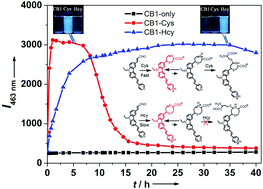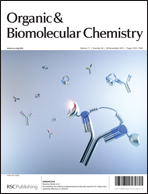Lighting up cysteine and homocysteine in sequence based on the kinetic difference of the cyclization/addition reaction†
Abstract
A novel one- and two-photon fluorescent probe CB1 has been developed for discriminating Cys and Hcy in a successive manner with high selectivity. The discrete time-dependent fluorescent responses enable us to sequentially detect Cys and Hcy in different time windows. Two-step reaction and kinetic modes were used to explain the sensing mechanism. As a promising biosensor for cell imaging, CB1 has been confirmed to exhibit membrane permeability to intact cells, low cytotoxicity to viable cells and photostability to ultraviolet light excitation. Furthermore, the results from the control assay have shown that the one- and two-photon fluorescence of CB1 within cells is associated with intracellular mercapto biomolecules but yet there is little interference with physiological pH value, viscosity and common bioanalytes. Finally one- and two-photon fluorescent images of CB1 within living SiHa cells have been presented.


 Please wait while we load your content...
Please wait while we load your content...